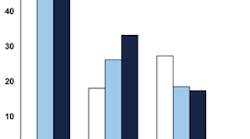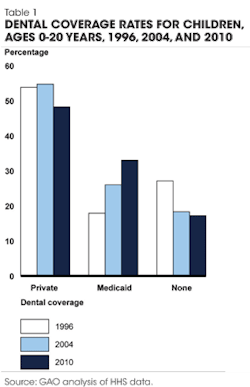by Christine Nathe, RDH, MS
Many of us remember the news reporting on financial forecasts regarding the Affordable Care Act. These forecasts were completed by the U.S. Government Accountability Office (GAO). The GAO is an independent, nonpartisan agency that works for Congress. Often called the "congressional watchdog," GAO investigates how the federal government spends taxpayer dollars.1 Recently, the GAO studied dental care use data in the United States.
As dental hygienists, we know the consequences of untreated dental disease and realize that many Americans do not regularly obtain dental care. In 2011, the Institute of Medicine reported that there is strong evidence that dental coverage is positively tied to access to and use of oral health care.2 For these reasons, the GAO was asked to examine dental services in the United States. The resulting report, entitled "Dental Services Information on Coverage, Payments, and Fee Variation," describes trends in coverage for, and use of, dental services; trends in payments by individuals and other payers for dental services; and the extent to which dental fees vary between and within selected communities across the nation.3
The GAO reported that the percentage of the population with private dental coverage decreased from 53% to 50% from 1996-2010, while the public coverage for dental care, via Medicaid and the State Children's Health Insurance Program (CHIPS), increased from 9% to 13%. This increase was attributed to the increase in the number of children covered by these federal-state health programs.3
The use of dental services, which is described by the percentage of individuals who had at least one dental visit, also remained relatively unchanged -- around 40% of individuals used dental services from 1996 to 2010. Unfortunately, although the use of public coverage increased, in 2010, children with public coverage still visited the dentist less often than privately insured children.
----------------------------------------------------------------
Other articles by Nathe:
- A bill from Vermont
- Spotlight on a pioneer dental hygienist
- Public health remains a part of dental hygiene career paths
----------------------------------------------------------------
Interesting data regarding preventive services were documented: among individuals who reported having a dental visit, there was an increase in the percentage reporting that they received diagnostic and preventive services (for example, exams and cleanings) and a decrease in those reporting that they received other services, such as restorative services (for example, fillings) from 1996 to 2010. GAO's analyses also discussed average annual dental payments and dental fees charged, which varied widely. The report suggested that most public health centers in GAO's review offered a 100% discount to the lowest-income patients for many, but not all, dental services.3
CHRISTINE NATHE, RDH, MS, is director at the University of New Mexico, Division of Dental Hygiene, in Albuquerque, N.M. She is also the author of "Dental Public Health Research" (www.pearsonhighered.com/educator), which is in its third edition with Pearson. She can be reached at [email protected] or (505)272-8147.
References
1. About the GAO. Retrieved from http://www.gao.gov/about/index.html on October 20, 2013.
2. Institute of Medicine Report Brief. Improving Access to Oral Health Care for Vulnerable and Underserved Populations. Washington, DC: Institute of Medicine. 2011. Retrieved from http://www.iom.edu/~/media/Files/Report%20Files/2011/Improving-Access-to-Oral-Health-Care-for-Vulnerable-and-Underserved-Populations/oralhealthaccess2011reportbrief.pdf on October 20, 2013.
3. GAO Report: Dental Services Information on Coverage, Payments, and Fee Variation. Retrieved from http://www.gao.gov/products/D05955 on October 20, 2013.
Past RDH Issues








